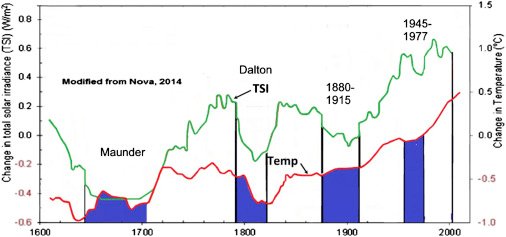The Maunder Minimum, also known as the "prolonged sunspot minimum", is the name used for the period around 1645 to 1715 during which sunspots became exceedingly rare
The Maunder Minimum roughly coincided with the middle part of the Little Ice Age, during which Europe and North America experienced colder than average temperatures.
The onset of the Little Ice Age also occurred well before the beginning of the Maunder minimum, and northern-hemisphere temperatures during the Maunder minimum were not significantly different from the previous 80 years, suggesting a decline in solar activity was not the main causal driver of the Little Ice Age.
https://en.wikipedia.org/wiki/Maunder_Minimum

Furthermore:
https://www.sciencedirect.com/topics/earth-and-planetary-sciences/maunder-minimum
After 1715 AD, the number of observed sunspots increased sharply from near zero to 50–100 and the global climate warmed.

1.3.3 Temperature, Sunspots, and Total Solar Irradiance
Temperatures during the Maunder closely correlate with SSNs and TSI (Fig. 14.11). When SSNs and TSI are low, temperatures are also low, and when SSNs and TSI are high, temperatures are high.
So, given the high sustained solar activity in the last 300 years, it had a snowball effect (no pun intended) causing a steady increase in temperature, i.e. the sun doesn't care about human emissions. Humans think they can fight the sun?
Maunder Minimum
The Maunder Minimum, also known as the "prolonged sunspot minimum", is the name used for the period around 1645 to 1715 during which sunspots became exceedingly rare, as was then noted by solar observers.
The term was introduced after John A. Eddy published a landmark 1976 paper in Science. Astronomers before Eddy had also named the period after the solar astronomers Annie Russell Maunder (1868–1947) and her husband, Edward Walter Maunder (1851–1928), who studied how sunspot latitudes changed with time. The period which the spouses examined included the second half of the 17th century.